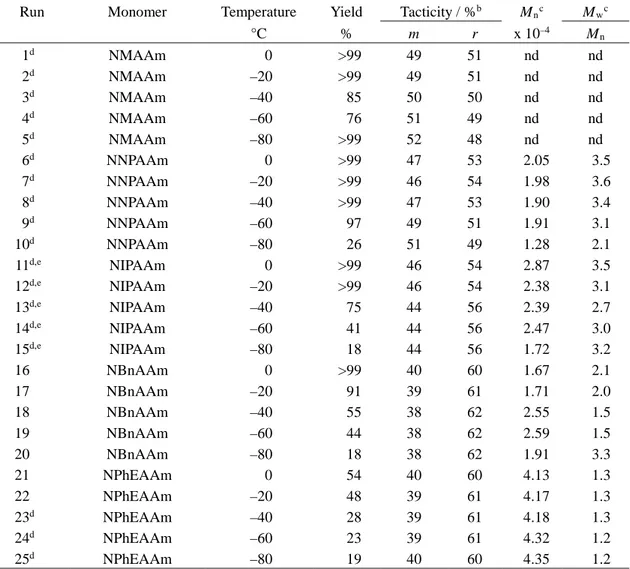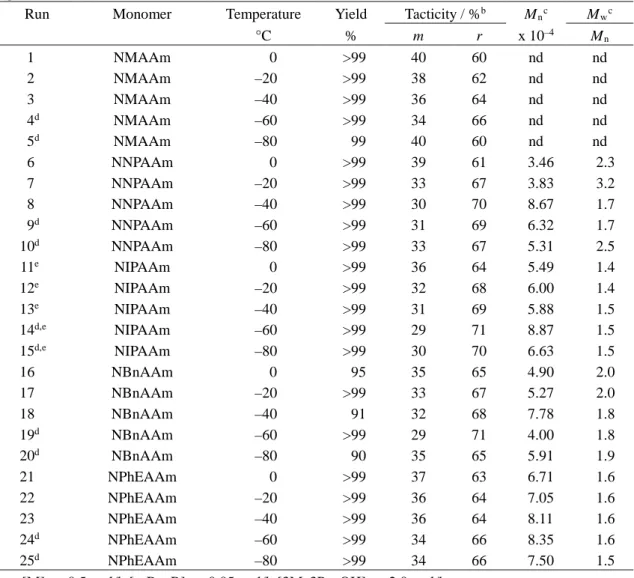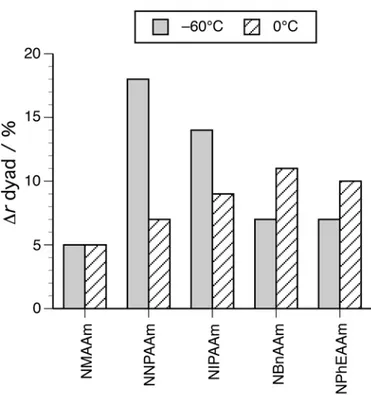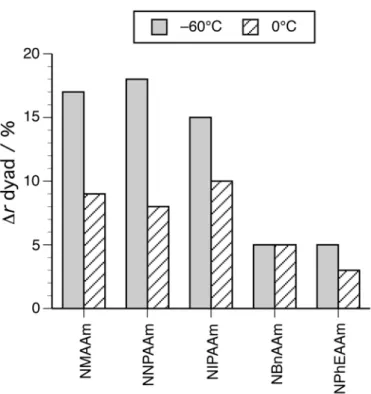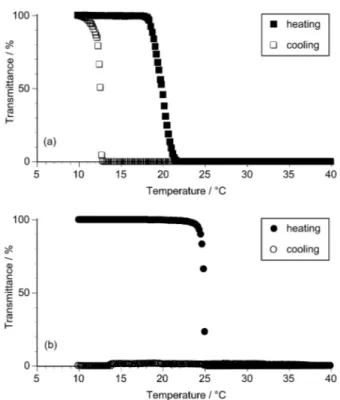Hydrogen-Bond-Assisted Syndiotactic-Specific Radical Polymerizations of
N-Alkylacrylamides: the Effect of the N-Substituents on the Stereospecificities and
Unusual Large Hysteresis in the Phase Transition Behavior of Aqueous Solution of Syndiotactic Poly(N-n-propylacrylamide)
TOMOHIRO HIRANO1, KIMIHIKO NAKAMURA1, TAKAHIRO KAMIKUBO1,
SATOSHI ISHII1, KANAMI TANI1, TAKESHI MORI2, TSUNEYUKI SATO1
1Institute of Technology and Science, Tokushima University, Minamijosanjima 2-1,
Tokushima 770-8506, Japan
2Department of Applied Chemistry, Kyushu University, 744 Moto-oka Nishi-ku,
Fukuoka 819-0395, Japan
Correspondence to : T. Hirano (E-mail: hirano@chem.tokushima-u.ac.jp)
ABSTRACT: The radical polymerizations of N-alkylacrylamides, such as N-methyl-
(NMAAm), N-n-propyl- (NNPAAm), N-benzyl- (NBnAAm), and N-(1-phenylethyl)acrylamides (NPhEAAm), at low temperatures were investigated in the absence or presence of hexamethylphosphoramide (HMPA) and 3-methyl-3-pentanol (3Me3PenOH), which induced the syndiotactic-specificities in the radical polymerization of N-isopropylacrylamide (NIPAAm). In the absence of the syndiotactic-specificity
This is the peer reviewed version of the following article: Hirano, T., Nakamura, K., Kamikubo, T., Ishii, S., Tani, K., Mori, T. and Sato, T. (2008), Hydrogen‐bond‐ assisted syndiotactic‐specific radical polymerizations of N‐alkylacrylamides: The effect of the N‐substituents on the stereospecificities and unusual large hysteresis in the phase‐transition behavior of aqueous solution of syndiotactic poly(N‐n‐propylacrylamide). J. Polym. Sci. A Polym. Chem., 46: 4575-4583., which has been published in final form at https://doi.org/10.1002/pola.22797. This article may be used for non-commercial purposes in accordance with Wiley Terms and Conditions for Use of Self-Archived Versions.
inducers, the syndiotacticities of the obtained polymers gradually increased as the bulkiness of the N-substituents increased. Both HMPA and 3Me3PenOH induced the syndiotactic-specificities in the NNPAAm polymerizations as well as in the NIPAAm polymerizations. The addition of 3Me3PenOH into the polymerizations of NMAAm significantly induced the syndiotactic-specificities, whereas the tacticities of the obtained polymers were hardly affected by adding HMPA. In the polymerizations of bulkier monomers, such as NBnAAm and NPhEAAm, HMPA worked as the syndiotactic-specificity inducer at higher temperatures, whereas 3Me3PenOH hardly influenced the stereospecificity, regardless of the temperatures. The phase transition behaviors of the aqueous solutions of poly(NNPAAm)s were also investigated. It appeared that the poly(NNPAAm) with racemo dyad content of 70% exhibited unusual large hysteresis between the heating and cooling processes.
Keywords: stereospecific polymers; radical polymerization; stimuli-sensitive polymers;
hydrogen bond; N-alkylacrylamides; syndiotactic
INTRODUCTION
Stereospecific polymerization has been received much attention, because the stereoregularity of polymers significantly affects their properties. Recently, stereoregular poly(N-isopropylacrylamide)s were successfully synthesized via anionic polymerizations of protected monomers, followed by deprotection.1-2 However, it is difficult to prepare
other stereoregular poly(N-alkylacrylamide)s via anionic polymerizations, because the N-H groups of the corresponding monomers have to be protected prior to the polymerization reactions.
On the other hand, direct syntheses of stereoregular poly(NIPAAm)s via radical polymerizations have been reported by some research groups including our group. The addition of Lewis acids,3 Lewis bases,4-6 or alcohol compounds7 was found to provide a
wide range of stereoregular poly(NIPAAm)s such as isotactic, syndiotactic, and heterotactic ones. It is expected to easily prepare stereoregular poly(N-alkylacrylamide)s via the radical polymerizations, because protections of the N-H group of the monomers is not required.
We have reported the hydrogen-bond-assisted stereospecific radical polymerizations of NIPAAm, in which Lewis bases and alcohol compounds play important roles as stereocontrolling auxiliaries. For example, the addition of hexamethylphosphoramide (HMPA)4(c) or 3-methyl-3-pentanol (3Me3PenOH)7(a) to the
NIPAAm polymerizations in toluene at –60°C afforded directly poly(NIPAAm) with racemo (r) dyad content of 72% or 71%. Thus, we examined the effect of the N-substituent on the syndiotactic-specificities of the radical polymerizations of N-alkylacrylamides, such as N-methylacrylamide (NMAAm), N-n-propylacrylamide (NNPAAm), N-benzylacrylamide (NBnAAm), and N-(1-phenylethyl)acrylamide (NPhEAAm), at low temperatures in the presence of HMPA or 3Me3PenOH.
extensively studied.8-10 Among the polymers examined in this study, poly(NNPAAm) is
also known as a thermosensitive polymer.11-16 Although poly(NNPAAm) has C-3 alkyl
groups as the N-substituents as well as poly(NIPAAm), it is well known that the phase transition behaviors, such as the temperature and the cooperativity, of the poly(NNPAAm) aqueous solutions are quite different from those of the poly(NIPAAm) solutions. Based on the fact that the stereoregularity of poly(NIPAAm) strongly affects the phase transition behaviors,7(a),17 it is assumed that the phase transition behaviors of the
poly(NNPAAm) solutions also depend on the stereoregularity. Thus, we examined the phase transition behaviors of the poly(NNPAAm) solutions and found unusual hysteresis for the poly(NNPAAm) with r = 70%. The preliminary results of the unusual phase transition behaviors are reported here in addition to the polymerization results.
Experimental Materials
NMAAm (supplied by Kohjin Co., Ltd) was fractionally distilled before use. Toluene was purified through washing with sulfuric acid, water, and 5% aqueous NaOH; this was followed by fractional distillation. Tri-n-butylborane (n-Bu3B) as a THF solution (1.0M),
HMPA (Aldrich Chemical Co.), and 3Me3PenOH (Tokyo Kasei Kogyo Co.) were used without further purification for polymerization reactions.
NNPAAm
To a stirred solution of n-propylamine (35.4g, 0.60mol) and triethylamine (59.9g, 0.50mol) in dichloromethane (200ml) were added acryloyl chloride (45.3g, 0.50mol) in dichloromethane (100ml) dropwise over 3h at 3 ~ 5°C. The mixture was stirred for 24h at room temperature, washed with 10% NaHCO3, and dried over MgSO4. After filtration,
the solvent was evaporated. The distillation in vacuo (91 ~ 95°C, 3mmHg) afforded pure NNPAAm (25g, 44%): 1H NMR (400MHz, CDCl3 at 35°C), δ 0.94 (t, 3H, 3J = 7.4Hz),
1.57 (sext, 2H, 3J = 7.1Hz, 3J = 7.4Hz), 3.29 (dt, 2H, 3J = 6.0Hz, 3J = 7.1Hz), 5.61 (dd, 1H, 2J = 1.6Hz, , 3J = 10.2Hz), 5.93 (bs, 1H), 6.12 (dd, 1H, 3J = 10.2Hz, 3J = 17.0Hz), and 6.25
(dd, 1H, 2J = 1.6Hz, 3J = 17.0Hz).
NBnAAm
To a stirred solution of benzylamine (90.0g, 0.84mol) in benzene (200ml) was added acryloyl chloride (36.2g, 0.40mol) in benzene (50ml) dropwise over 3h at 3 ~ 5°C. The mixture was stirred for 24h at room temperature. After the solid precipitate was removed by filtration, the solvent was evaporated. Recrystallization from the hexane-benzene mixture yielded crude NBnAAm as a white solid. The NBnAAm was further purified by column chromatography (silica gel, hexane : ethyl acetate = 1:1): m. p. 62.5-63.5 °C, 1H
NMR (400MHz, CDCl3 at 35°C), δ 4.49 (d, 2H, 3J = 5.8Hz), 5.64 (dd, 1H, 2J = 1.5Hz, 3J
= 10.2Hz), 6.07 (bs, 1H), 6.12 (dd, 2H, 3J = 10.2Hz, 3J = 17.0Hz), 6.29 (dd, 1H, 2J =
NPhEAAm
To a stirred solution of 1-phenylethylamine (24.0g, 0.20mol) and triethylamine (20.1g, 0.20mol) in dichloromethane (150ml) were added acryloyl chloride (18.1g, 0.18mol) in dichloromethane (50ml) dropwise over 5h at 0 ~ 3°C. The mixture was stirred for 24h at room temperature, washed with water, and dried over MgSO4. After filtration, the
solvent was evaporated to yield crude NPhEAAm. The NPhEAAm was purified by column chromatography (silica gel, ethyl acetate) (26.8 g, 85 %): m. p. 61-62 °C, 1H
NMR (400MHz, CDCl3 at 35°C), δ 1.52 (d, 3H, 3J = 6.9Hz), 5.20 (quintet, 1H, 3J = 6.9Hz, 3J = 7.9Hz), 5.61 (dd, 1H, 2J = 1.5Hz, 3J = 10.2Hz), 5.96 (bs, 1H), 6.09 (dd, 1H, 3J =
10.2Hz, 3J = 17.0Hz), 6.26 (dd, 1H, 2J = 1.5Hz, 3J = 17.0Hz), and 7.23-7.37 (m, 5H).
Polymerization
Typical polymerization procedure is as follows; NNPAAm (0.314 g, 2.8 mmol) was dissolved in toluene to prepare a 5 mL solution (0.56 mol/L). Four milliliter of the solution was transferred to the glass ampoule and cooled at 0°C. The polymerization was initiated by adding n-Bu3B solution (0.22 mL) into the monomer solution.18 After 24h,
the reaction was terminated with a small amount of THF solution of 2,6-di-t-butyl-4-methylphenol at polymerization temperature.
The polymerization mixtures were poured into a large amount of diethyl ether (NMAAm, NNPAAm, NIPAAm, and NBnAAm) or methanol (NPhEAAm). The precipitated polymers were collected by filtration or centrifugation, and dried in vacuo. The polymer yields were determined gravimetrically.
Measurements
The 1H NMR spectra were measured on an EX-400 spectrometer (JEOL Ltd.) operated at
400MHz. The synthesized monomers were measured in CDCl3 at 35°C. The tacticities
of the obtained polymers were determined from 1H NMR signals due to methylene group
(if necessary, both methylene and methine groups) in main chain, measured in deuterated dimethyl sulfoxide (DMSO-d6) at 150°C. The molecular weights and molecular weight
distributions of the polymers were determined by size exclusion chromatography (SEC) (HLC 8220 instrument, Tosoh Co.) equipped with TSK gels (SuperHM-M and SuperHM-H, Tosoh Co.) using dimethylformamide (LiBr 10 mmol/l) as an eluent at 40°C ([polymer] = 1.0 mg/ml, flow rate = 0.35 ml/min). The SEC chromatogram was calibrated with standard polystyrene samples. The transmittance of a poly(NNPAAm) solution (0.1 w/v%) was monitored at 500 nm as a function of temperature with a UV/VIS spectrophotometer (V-550, JASCO Co.). The temperature was changed at 0.5 °C/min. The cloud point (Tc) was defined as the temperature at which the transmittance is 50% in
the heating and cooling processes.
RESULTS AND DISCUSSION
Effect of the N-Substituents on the Stereospecificities in the Radical Polymerizations of N-Alkylacrylamides in the Absence of Syndiotactic-Specificity-Inducers
radical polymerizations of N-alkylacrylamides in toluene at low temperatures in the absence of syndiotactic-specificity-inducers such as HMPA and 3Me3PenOH (Table 1). Polymers were obtained almost quantitatively at higher temperatures, except for the polymerizations of NPhEAAm.19 The polymer yields gradually decreased, as the
polymerization temperature decreased. The tendency was enhanced with an increase in the bulkiness of the N-substituents. The molecular weights of the polymers, obtained under the given conditions, were within the same order of magnitude,20 whereas those of
poly(NPhEAAm)s were somewhat higher.19
<Table 1>
Almost completely atactic polymers were obtained by the radical polymerizations of NMAAm, regardless of the polymerization temperature (Table 1, runs 1-5). However, the r dyad contents of the obtained polymers gradually increased, as the bulkiness of the N-substituents increased. The polymers with r = 62% were obtained from the NBnAAm polymerizations even in the absence of the syndiotactic-specificity-inducers (Table 1, runs 18-20). Similar effect of the bulkiness of the side group on the stereospecificities has been reported for the radical polymerizations of acrylates.21
Effect of the N-Substituents on the Syndiotactic-Specificities in the Radical Polymerizations of N-Alkylacrylamides in the Presence of HMPA
Table 2 summarizes the results of the radical polymerizations of N-alkylacrylamides in toluene at low temperatures in the presence of HMPA. The molecular weights of the obtained polymers decreased as compared with those in the absence of HMPA, except for the NPhEAAm polymerizations.19 The addition of HMPA tended to decrease the yields.
In particular, poly(NMAAm)s were obtained in lower yields.
<Table 2>
The r dyad contents of the obtained polymers increased with the addition of HMPA, although HMPA hardly induced the syndiotactic-specificities in the radical polymerizations of NMAAm (Table 2, runs 1-5). In the polymerizations of NNPAAm and NIPAAm, the r dyad contents gradually increased with decreasing the temperature and the polymers with highest syndiotactic values were obtained at –60°C (Table 2, runs 9 and 14). On the other hand, in the polymerizations of NBnAAm and NPhEAAm, the r dyad content gradually decreased with a decrease in the temperature, although the polymers obtained at higher temperatures had syndiotacticity higher than those of poly(NNPAAm)s and poly(NIPAAm)s obtained at the corresponding temperatures.
Figure 1 shows the increases in r dyad contents with the addition of HMPA to the radical polymerizations at –60°C and 0°C. In addition to the above-mentioned finding that HMPA hardly induced the syndiotactic-specificity in the NMAAm polymerizations, Figure 1 demonstrates that, as the bulkiness of the N-substituents increased, the effect of HMPA on the syndiotactic-specificity decreased for the
polymerizations at –60°C, whereas an opposite tendency was observed for the polymerizations at 0°C.
<Figure 1>
Effect of the N-Substituents on the Syndiotactic-Specificities in the Radical Polymerizations of N-Alkylacrylamides in the Presence of 3Me3PenOH
The effect of the N-substituents on the syndiotactic-specificities in the radical polymerizations of N-alkylacrylamides in the presence of 3Me3PenOH was examined (Table 3). In contrast with the HMPA-mediated polymerizations, both the polymer yields and the molecular weights of the obtained polymers increased as compared with those obtained in the absence of the syndiotactic-specificity-inducers.
<Table 3>
Polymers rich in syndiotacticity were obtained, regardless of the bulkiness of the N-substituents. In particular, NMAAm afforded polymer with r = 66% at –60°C (Table 3, run 4), whereas HMPA hardly induced the syndiotactic-specificities in the NMAAm polymerizations as mentioned above. Thus, this is the first synthesis of predominantly syndiotactic poly(NMAAm). Figure 2 shows the increases in r dyad contents by adding 3Me3PenOH into the radical polymerizations at –60°C and 0°C. It appeared that the syndiotactic-specificity induced by 3Me3PenOH increased with the
decrease in the bulkiness of the N-substituents and the tendency was enhanced by lowering the temperature to –60°C.
<Figure 2>
The Difference between HMPA and 3Me3PenOH as the Syndiotactic-Specificity-Inducers
We have reported that complex formations of HMPA with the N-H groups of both the NIPAAm monomers and the propagating chain-ends, through a hydrogen-bonding interaction (N-H ••• O=P), are responsible for the induction of the syndiotactic-specificity.4(b) However, complex formation between the NIPAAm
monomers and Lewis bases would reduce the polymerizability of the monomers, because of the cross-conjugated structure of the monomers.6(b),7(c) If NMAAm was used as a
monomer, it is assumed that NMAAm formed the complex with HMPA strongly more than NIPAAm, due to the less bulkiness of methyl group. Taking into account that, with the addition of HMPA, the yields of poly(NMAAm)s reduced more than other polymers, such strong complexation would reduce the polymerizability of NMAAm remarkably so that non-stereospecific free monomers should have much higher polymerizability than the syndiotactic-specific complexed monomer. If so, it is assumed that the incorporation of free monomers into propagation steps increases in the NMAAm polymerizations, although the concentration of the free monomer should be low. Consequently, the syndiotactic-specificity would not be induced effectively in the NMAAm
polymerizations.
In the polymerizations at 0°C, the induced syndiotactic-specificity increased with the increase in the bulkiness of the monomers (Figure 1). This result suggests that HMPA essentially induces the syndiotactic-specificity in the polymerizations of bulkier monomers. However, the induced syndiotactic-specificity decreased by lowering the temperature to –60°C in the polymerizations of bulkier monomers such as NBnAAm and NPhEAAm. It is probably because, in these polymerization systems, the polymerizability of the complexed monomer further decreased because of not only the cross-conjugated structures of N-alkylacrylamides but also an increase in the steric repulsion between the complexed monomers and the complexed propagating chain-ends.
On the other hand, it has been revealed that the added alcohols formed hydrogen-bonding interactions both with N-H groups and C=O groups of the NIPAAm monomers, the latter of which should accelerate the polymerization reaction.22-24 Thus,
the polymerization would proceed by preferential consumption of the complexed monomers. In other words, the more the monomers form the complexes with the added alcohols, the more strongly the syndiotactic-specificity should be induced. Indeed, the syndiotactic-specificities were significantly induced in the polymerizations of less bulky monomers such as NMAAm.
Poly(NNPAAm)
In the previous paper,7(a) we have reported the phase transition behaviors of
poly(NIPAAm)s with r dyad contents of 53 % and 71 % (0.1 w/v%, heating and cooling rates = 0.5 °C/min). Significant effects of the increase in the dyad syndiotacticity from 53% to 71% on the phase transition behaviors of aqueous solutions of poly(NIPAAm)s were revealed as follows: (1) the phase transition temperature slightly increased. (2) the phase transition behaviors were sharpened. (3) the hysteresis between the heating and cooling processes reduced. Thus, we investigated the phase transition behaviors of poly(NNPAAm)s, which have similar syndiotacticity (r = 53 % and 70 %) as those of the poly(NIPAAm)s, to examine the effect of the N-substituents.
Figure 3 shows the temperature dependences of the transmittance of aqueous solutions of poly(NNPAAm)s with r dyad contents of (a) 53% and (b) 70%. As compared with atactic poly(NIPAAm) (r = 53%),7(a) phase transitions of atactic poly(NNPAAm) in
both the heating and cooling processes were observed at lower temperatures.11-16
Furthermore, atactic poly(NNPAAm) exhibited a larger hysteresis between the heating and cooling processes and a broader phase transition than atactic poly(NIPAAm) under the given conditions.7(a)
<Figure 3>
In the heating process, Tc increased by 5.0°C (from 19.9 to 24.9 °C) with an
was obviously sharpened. These results are consistent with those observed for the aqueous solutions of poly(NIPAAm)s.7(a) Surprisingly, the transmittance never
recovered in the cooling process even after lowering the temperature to 10°C, indicating that syndiotactic poly(NNPAAm) exhibited a large hysteresis (at least over 15°C) under the given conditions. This result disagrees with the small hysteresis observed in the phase transition of aqueous solution of poly(NIPAAm)s with r dyad of 71%, measured under the corresponding conditions.7(a)
Such large thermal hystereses in the phase transition behaviors have been reported for some synthetic polymers.3(b),4(c),17,25-27 For instance, we have reported that
poly(NIPAAm) with r dyad of 75% showed similar large hysteresis. However, the poly(NIPAAm) was solvent-fractionated according to the stereoregularity from the polymer with r = 72% prepared by HMPA-mediated syndiotactic-specific radical polymerization, in which the syndiotacticity of the obtained polymers gradually increased with the polymer yield.4(c) This means that the solvent-fractionated polymer also has a
distribution in the stereoregularity and the syndiotacticity of 75% is also an average value. In other words, the polymer contains more highly syndiotactic polymer fractions, which probably contribute to the large hysteresis. Consequently, these results suggest that both poly(NIPAAm) and poly(NNPAAm) exhibit large thermal hystereses in the phase transition behaviors with an increase in the syndiotacticity, but the influence of the syndiotacticity appears more markedly for poly(NNPAAm) than for poly(NIPAAm).
To examine whether the suspension was how much steady, the temperature was maintained at 20°C during the cooling process. The opaque state remained even after 3h,
indicating that the suspension was pretty stable. However, the suspension was easily changed into a completely transparent state by vigorous shaking after the cooling process and such large hystereses were repeatedly observed as long as the poly(NNPAAm) was dissolved. These results imply that the syndiotactic poly(NNPAAm) solution can be applied as memory devices, which respond to the temperature.
CONCLUSIONS
It was found that the syndiotactic-specificity gradually increased with the bulkiness of the N-substituents of the monomers, even if HMPA and 3Me3PenOH were not added. The addition of HMPA significantly induced the syndiotactic-speicificities in the radical polymerizations of N-alkylacrylamides, except for NMAAm, although the effective temperature strongly depended on the bulkiness of the N-substituents. On the other hand, the addition of 3Me3PenOH significantly induced the syndiotactic-specificities in the radical polymerizations of less bulky monomers at lower temperatures. Such difference is probably ascribed to the difference in the structure of the hydrogen-bond-assisted complexes. Furthermore, unusual hysteresis was observed in the phase transition behavior of the aqueous solution of poly(NNPAAm) with r = 70 %. Further work is in progress to investigate the relationship between the phase transition behavior and the stereoregularity of poly(NNPAAm) in more detail.
This work was supported in part by a Grant-in-Aid for Young Scientists (B) (18750102) from the Ministry of Education, Culture, Sports, Science and Technology.
REFERENCES AND NOTES
1. Kitayama, T.; Shibuya, W.; Katsukawa, K. Polym J 2002, 34, 405-409.
2. (a) Ito, M.; Ishizone, T. Designed Monomer Polym. 2004, 7, 11-24. (b) Ito, M.; Ishizone, T. J Polym Sci: Part A: Polym Chem 2006, 44, 4832-4845.
3. (a) Isobe, Y.; Fujioka, D.; Habaue, S.; Okamoto, Y. J Am Chem Soc 2001, 123, 7180-7181. (b) Habaue, S.; Isobe, Y.; Okamoto, Y. Tetrahedron 2002, 58, 8205-8209.
4. (a) Hirano, T.; Miki, H.; Seno, M.; Sato, T. J Polym Sci: Part A: Polym Chem 2004, 42, 4404-4408. (b) Hirano, T.; Miki, H.; Seno, M.; Sato T. Polymer 2005, 46, 3693-3699. (c) Hirano, T.; Miki, H.; Seno, M.; Sato T. Polymer 2005, 46, 5501-5505.
5. (a) Hirano, T.; Ishii, S.; Kitajima, H.; Seno, M.; Sato, T. J Polym Sci: Part A: Polym Chem 2005, 43, 50-62. (b) Hirano, T.; Kitajima, H.; Ishii, S.; Seno, M.; Sato, T. J Polym Sci: Part A: Polym Chem 2005, 43, 3899-3908. (c) Hirano, T.; Kitajima, H.; Seno, M.; Sato T. Polymer 2006, 47, 539-546.
6. (a)Hirano, T.; Ishizu, H.; Seno, M.; Sato T. Polymer 2005, 46, 10607-10610. (b) Hirano, T.; Ishizu, H.; Sato T. Polymer 2008, 49, 438-445.
7. (a) Hirano, T.; Okumura, Y.; Kitajima, H.; Seno, M.; Sato, T. J Polym Sci: Part A: Polym Chem 2006, 44, 4450-4460. (b) Hirano, T.; Kamikubo, T.;
Okumura, Y.; Sato, T. Polymer 2007, 48, 4921-4925. (c) Hirano, T.; Kamikubo, T.; Fujioka, Y.; Sato, T. Polymer in press.
8. Heskins, M.; Guillet, J. E. J Macromol Sci A Chem 1968, 2, 1441-1455.
9. Schild, H. G. Porg Polym Sci 1992, 17, 163-249.
10. Rzaev, Z. M. O.; Dinçer, S.; Piskin, E. Prog Polym Sci 2007, 32, 534-595. 11. Ito, S. Kobunshi Ronbunshu 1989, 46, 437-443.
12. Inomata, H.; Yagi, Y.; Saito, S. Macromolecules 1990, 23, 4887-4888.
13. (a) Ito, D.; Kubota, K. Macromolecules 1997, 30, 7828-7834. (b) Ito, D.; Kubota, K. Polym J 1999, 31, 254-257.
14. Seker, F.; Ellis A. B. J Polym Sci: Part A: Polym Chem 1998, 36, 2095-2102. 15. Maeda, Y.; Nakamura, T.; Ikeda, I. Macromolecules 2001, 1391-1399. 16. Cao, Y.; Zhu, X. X.; Luo, J.; Liu, H. Macromolecules, 2007, 40, 6481-6488. 17. Ray, B.; Okamoto, Y.; Kamigaito, M.; Sawamoto, M.; Seno, K.; Kanaoka, S.;
Aoshima, S. Polym J 2005, 37, 234-237.
18. Zhang, Z.; Chung, T. C. M. Macromolecules 2006, 39, 5187-5189.
19. Based on the fact that both the polymer yields were low and the molecular weight distributions of poly(NPhEAAm)s were quite narrow, poly(NPhEAAm)s with lower molecular weights were not precipitated into methanol.
20. The molecular weights and molecular weight distributions of poly(NMAAm)s were not determined, since these polymers could not be detected by the RI
detector. This is probably because the refractive indices of these polymers were close to that of the eluent, DMF (LiBr 10 mmol/l).
21. (a) Uryu, T.; Shiroki, H.; Okada, M.; Hosonuma, K.; Matsuzaki, K. J Polym Sci Part A-1 1971, 9, 2335-2342. (b) Matsuzaki, K.; Okada, M.; Hosonuma, K. J Polym Sci Part A-1 1972, 10, 1179-1186.
22. Morrison, D. A.; Davis, T. P. Macromol Chem Phys 2000, 201, 2128-2137. 23. Beuermann, S.; Nelke, D. Macromol Chem Phys 2003, 204, 460-470.
24. Lee, T. Y.; Roper, T. M.; Jönsson, E. S.; Guymon, C. A.; Hoyle, C. E. Macromolecules 2004, 37, 3659-3665.
25. Kobayashi, M.; Ishizone, T.; Nakahama, S. J Polym Sci: Part A: Polym Chem 2000, 38, 4677-4685.
26. Aoki, T.; Muramatsu, M.; Torii, T.; Sanui, K.; Ogata, N. Macromolecules 2001, 34, 3118-3119.
27. Mori, T.; Mori, H.; Beppu, S.; Makimura, T.; Minagawa, K.; Tanaka, M.; Niidome T.; Katayama, Y. 33rd Annual Meeting & Exposition of the Controlled Release Society, Transactions, 2006, p915.
Table 1. Radical polymerization of N-alkylacrylamides in toluene for 24 h at low temperatures in the
absence of the syndiotactic-specificity inducersa
Run Monomer Temperature Yield Tacticity / %b M
nc Mwc °C % m r x 10–4 M n 1d 2d 3d 4d 5d 6d 7d 8d 9d 10d 11d,e 12d,e 13d,e 14d,e 15d,e 16 17 18 19 20 21 22 23d 24d 25d NMAAm NMAAm NMAAm NMAAm NMAAm NNPAAm NNPAAm NNPAAm NNPAAm NNPAAm NIPAAm NIPAAm NIPAAm NIPAAm NIPAAm NBnAAm NBnAAm NBnAAm NBnAAm NBnAAm NPhEAAm NPhEAAm NPhEAAm NPhEAAm NPhEAAm 0 –20 –40 –60 –80 0 –20 –40 –60 –80 0 –20 –40 –60 –80 0 –20 –40 –60 –80 0 –20 –40 –60 –80 >99 >99 85 76 >99 >99 >99 >99 97 26 >99 >99 75 41 18 >99 91 55 44 18 54 48 28 23 19 49 49 50 51 52 47 46 47 49 51 46 46 44 44 44 40 39 38 38 38 40 39 39 39 40 51 51 50 49 48 53 54 53 51 49 54 54 56 56 56 60 61 62 62 62 60 61 61 61 60 nd nd nd nd nd 2.05 1.98 1.90 1.91 1.28 2.87 2.38 2.39 2.47 1.72 1.67 1.71 2.55 2.59 1.91 4.13 4.17 4.18 4.32 4.35 nd nd nd nd nd 3.5 3.6 3.4 3.1 2.1 3.5 3.1 2.7 3.0 3.2 2.1 2.0 1.5 1.5 3.3 1.3 1.3 1.3 1.2 1.2 a. [M]0 = 0.5 mol/l, [n-Bu3B]0 = 0.05 mol/l.
b. Determined by 1H NMR signals due to methylene group. c. Determined by SEC (polystyrene standards).
d. Monomer, polymer or both were precipitated during a polymerization reaction. e. Data taken from Ref. 5(a).
Table 2. Radical polymerization of N-alkylacrylamides in toluene for 24 h at low temperatures in the
presence of HMPAa
Run Monomer Temperature Yield Tacticity / %b M
nc Mwc °C % m r x 10–4 M n 1 2 3 4 5d 6 7 8 9 10d 11e 12e 13e 14e 15e 16 17 18 19d 20d 21 22 23 24 25d NMAAm NMAAm NMAAm NMAAm NMAAm NNPAAm NNPAAm NNPAAm NNPAAm NNPAAm NIPAAm NIPAAm NIPAAm NIPAAm NIPAAm NBnAAm NBnAAm NBnAAm NBnAAm NBnAAm NPhEAAm NPhEAAm NPhEAAm NPhEAAm NPhEAAm 0 –20 –40 –60 –80 0 –20 –40 –60 –80 0 –20 –40 –60 –80 0 –20 –40 –60 –80 0 –20 –40 –60 –80 80 43 49 56 36 99 97 99 97 83 98 >99 99 >99 86 76 97 97 78 66 10 30 37 7 18 44 43 45 46 47 40 35 32 31 38 37 34 32 30 36 29 29 28 31 33 30 28 31 32 39 56 57 55 54 53 60 65 68 69 62 63 66 68 70 64 71 71 72 69 67 70 72 69 68 61 nd nd nd nd nd 0.67 0.91 0.82 0.74 1.77 0.91 0.97 1.30 1.02 1.25 1.73 1.23 1.29 2.53 2.92 3.26 4.20 4.65 4.26 4.36 nd nd nd nd nd 1.7 2.0 1.8 1.8 1.7 1.6 1.7 2.2 1.9 1.6 2.2 2.1 1.5 1.8 2.0 1.2 1.2 1.3 1.2 1.2 a. [M]0 = 1.0 mol/l, [n-Bu3B]0 = 0.10 mol/l, [HMPA]0 = 2.0 mol/l.
b. Determined by 1H NMR signals due to methylene group. c. Determined by SEC (polystyrene standards).
d. Monomer, polymer or both were precipitated during a polymerization reaction. e. Data taken from Ref. 4(b).
Table 3. Radical polymerization of N-alkylacrylamides in toluene for 24 h at low temperatures in the
presence of 3Me3PenOHa
Run Monomer Temperature Yield Tacticity / %b M
nc Mwc °C % m r x 10–4 M n 1 2 3 4d 5d 6 7 8 9d 10d 11e 12e 13e 14d,e 15d,e 16 17 18 19d 20d 21 22 23 24d 25d NMAAm NMAAm NMAAm NMAAm NMAAm NNPAAm NNPAAm NNPAAm NNPAAm NNPAAm NIPAAm NIPAAm NIPAAm NIPAAm NIPAAm NBnAAm NBnAAm NBnAAm NBnAAm NBnAAm NPhEAAm NPhEAAm NPhEAAm NPhEAAm NPhEAAm 0 –20 –40 –60 –80 0 –20 –40 –60 –80 0 –20 –40 –60 –80 0 –20 –40 –60 –80 0 –20 –40 –60 –80 >99 >99 >99 >99 99 >99 >99 >99 >99 >99 >99 >99 >99 >99 >99 95 >99 91 >99 90 >99 >99 >99 >99 >99 40 38 36 34 40 39 33 30 31 33 36 32 31 29 30 35 33 32 29 35 37 36 36 34 34 60 62 64 66 60 61 67 70 69 67 64 68 69 71 70 65 67 68 71 65 63 64 64 66 66 nd nd nd nd nd 3.46 3.83 8.67 6.32 5.31 5.49 6.00 5.88 8.87 6.63 4.90 5.27 7.78 4.00 5.91 6.71 7.05 8.11 8.35 7.50 nd nd nd nd nd 2.3 3.2 1.7 1.7 2.5 1.4 1.4 1.5 1.5 1.5 2.0 2.0 1.8 1.8 1.9 1.6 1.6 1.6 1.6 1.5 a. [M]0 = 0.5 mol/l, [n-Bu3B]0 = 0.05 mol/l, [3Me3PenOH]0 = 2.0 mol/l.
b. Determined by 1H NMR signals due to methylene group. c. Determined by SEC (polystyrene standards).
d. Monomer, polymer or both were precipitated during a polymerization reaction. e. Data taken from Ref. 7(a).
Figure 1. The increases in the r dyad contents of the obtained poly(N-alkylacrylamide)s
Figure 2. The increases in the r dyad contents of the obtained poly(N-alkylacrylamide)s
Figure 3. Temperature dependence of the light transmittance (500 nm) of aqueous
solutions of poly(NNPAAm)s (a) with r = 53 % and (b) with r = 70% (0.1 w/v%, heating and cooling rates = 0.5 °C/min).
